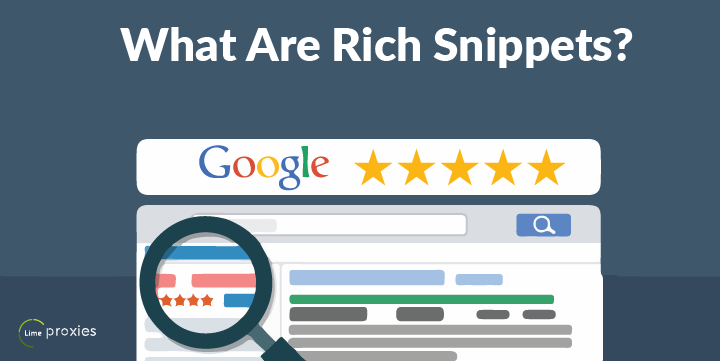
There are quite a few search engines available out there but the most popular one is Google. Almost 75% of the online users go for Google as their first choice and this number would have been much greater hadn’t China blocked Google.
The reason this matter is that when it comes to SEO, the main focus is always Google and to get the website listed on Google search results.
There are a lot of ways that one can optimize the website content to get easily listed on Google and one of them is by using Structured data.
Structured Data is a way of organizing the content of one’s website so that it becomes easy for the search engine to know what certain terms relate to.
In short, this makes it easy for the search engine to gather or extract data from the web page. This also enables Google to show special information related to the search query. For example, the data structure for a recipe page will include data like, cooking time, ingredient, calories, serving size, etc. So with this even if a parameter like calories is searched, this recipe can be included in search results.
Using the in-page markup, structured data is coded into the web page. It is important to know that the structured data corresponding to the web page should describe the data on that page. So you should refrain from creating blank pages just to add structured data or adding information that is not normally visible to the user.
Structured data format

Structured data can be divided into data that is required, optional and recommended. https://schema.org/ is used for most of the search structured data, however, Google recommends its own website developers.google.com
Google provides two testing tools, one for testing the structured data and one rich results status report which will help you gather information about your page after deployment.
If you wish to appear on special Google search results then you must add all properties of an object but Google recommends to provide less but accurate information rather than providing a whole lot of data with incomplete details.
Google supports the following format when it comes to structured data:
JSON-LD
JavaScript Object Notation for Linked Data, also known as JSON-LD is used to encode linked data using JSON.
Linked data helps users to publish and gather results from the web. In this way, a standard is created for machine readable data. JSON-LD is a format of Linked data and which is in a very simplified format making it very easy for humans to read and write.
Microdata
Microdata uses HTML to embed metadata within a web page. This is not the best way to describe structured data and even the creators themselves abandon it when it comes to describing structured data.
Below are few tools that might prove helpful when it comes to testing of structured data and rich snippet display.
- Google Structured Data Testing Tool not only helps in testing but also modifying and developing the structured markup. The data can be loaded directly or with the help of a URL
When using the tool for testing vocabularies or schemas, there are chances that few error messages come up, this can be related to the requirements of only a specific data consumer, especially when it is a validation error related to required fields or required properties.
- Yandex Structured data validator can be used for checking schema.org, microdata, microformats, Open Graph and RDF. This will help you make sure that the indexing robots get all the structured data.
- Bing Markup Validator, using this you will be able to verify the markup that has been added to your web pages. This also helps you to get an on-demand report which includes the markup Bing has discovered, including Schema.org, HTML Microdata, Microformats, RDFa, and OpenGraph. Simply sign in or sign up for Bing Webmaster Tools to start using the validator.
- Using JSON-LD Playground’s website, you can work around with JSON-LD markup by using the tool to type some JSON and check what gets generated from the written JSON. There are a lot of examples available on the website, you can pick up any and just get started.
- RDFa Play is a tool that will help you test your structured data. RDFa is an extension to HTML5 using which you can markup things like Places, People, Events, Recipes, and Reviews. Search Engines and Web Services make use of these markups to generate better search results and this in turn, helps people to get results very easily.
- Facebook Debugger can be used to check content when a web page is viewed on Facebook or Messenger. There is an option called Batch validator that will allow you to change information across multiple URLs at the same time.
- RDF Translator is a tool used to convert between different data formats like RDF/XML to Microdata, so it is also called as multi format conversion tool. Direct input or a URL can be used in the tool.
- Structured Data Linter is used by webmasters or developers to cross check the structured data that is present in their HTML pages. The format that can be used includes Microdata, JSON-LD, and RDFa.
- Structured Data Testing Tool is actually a Chrome extension which actually uses the Google Structured Data Testing Tool to check the rich snippets and structured data markup.
Google introduced the tool to test “Rich” data like rich snippets, rich cards of a web page, this is called as Rich Snippets Testing Tool.
What Are Rich Snippets?

Rich Snippets is used to define structured data markup that developers can add to their existing HTML web page, this is useful for the search engines, as it will help them better understand about the content on each web page. Search engines like Google are encouraging to use this is because it helps the engine to get richer search results.
Although it is not mandatory to use it, it is recommended because this helps the search engine, user and in turn help the website owner.
Following are the benefits of using rich snippets:
- Search results become more relevant
- Users will be able to get specific results based on the parameters used in such snippets on the search engine results page
- As the visitor will be getting relevant data, this will increase website traffic and also reduce bounce rate as the visitors will already know the gist of the content on the website
Normally the search results include the site URL along with the metadata specified but when rich snippets are used, the search engine will be able to show more information about the searched topic as shown in the below example.

This shows the search results for “Avengers 4”, you can notice how the video is directly available in the search result from a website instead of just a URL and metadata.
Below are the examples of data on which rich snippet can be used:
- Reviews: This can be a review of a movie, restaurant, etc. Review by an individual or by multiple people is supported.
- People: Nowadays when you search for any well known personality, their twitter, Facebook, Instagram, etc pages also come up. In the same way, this can be incorporated into a website that has information about the staff and can include details like role, name, title and contact details.
- Product: One of the most important uses of structured data is with products. The tags available are the product name, price, condition, seller info, brand, image, currency and quantity. This is very useful for e-commerce giants.
- Recipes: The structured data markup for recipes offer a wide range of properties that include cooking time, serving size, calories, and reviews.
- Events: This is usually used to define the upcoming events and of course not the ones that are already over. One can include properties like the venue, guest, date, and duration
- Music: Bing doesn’t provide for support for music but Google does. This can be the name of the artist, duration and album
Structured data markup makes us of three primary elements
- Itemscope is used to define the HTML added in block
- Itemtype gives information about the type of item it is
- Itemprop is used to define properties such as name, URL, etc
Google has come up with the term “rich results” to refer to all of these types of properties that was discussed above, so the testing tool is called the rich results testing tool.
This tool helps in testing all types of structured data that will help in enhancing the rich search results.
It also gives you a preview of how the search result will appear on Google and even lets you test structured data embedded in dynamic content i.e the content which keeps changing.
<img class="alignnone size-large wp-image-2851" src="/assets/asrc="/.jpg" alt="rich snippets testing tool" width="720" height="352" />
Now that your website is tested for rich snippets, what to Expect After Adding Rich Snippets to your web page?
Google will not right away start displaying your web page’s rich snippet in Google search results, instead, it analyzes and checks the data before starting to display it.
- It might take Google 10-14 days to even start to assess after rich snippets are added to the website
- After this, some of your page result in Google will show rich snippets but not for all yet, provided Google didn’t find any error while analyzing. This will disappear after 4-5 days
- After a few days, the rich snippet will appear back, this may be for the same pages or new ones
- This process is repeated and eventually, all your web pages will appear on Google.
Always go for ethical ways to put up your rich snippets on Google. Google can even penalise website if they found that the rich snippets are not being used properly and the warning will look something like:
“Markup on some pages on this site appears to use techniques such as marking up content that is invisible to users, marking up irrelevant or misleading content, and/or other manipulative behavior that violates Google’s Rich Snippet Quality guidelines.”
When it comes to Search Engine Optimisation, small successes can eventually lead to exponential growth.
You could also check this SEO Checklist 2019 and data science tools.
Post Quick Links
Jump straight to the section of the post you want to read:


About the author
Rachael Chapman
A Complete Gamer and a Tech Geek. Brings out all her thoughts and Love in Writing Techie Blogs.
Related Articles
10 Common Security Threats To Ecommerce
These days, the world is a global village, and e-commerce is how trade happens online, between countries and continents and across cultures and seas.
Proxy Servers Explained
Proxy servers are essential to ensuring data protection, privacy and better connectivity. Here's your ultimate guide to proxy servers by Limeproxies